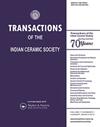实验方案对二硅酸锂基牙科玻璃陶瓷抗弯强度测试的影响
IF 1.5
4区 材料科学
Q3 MATERIALS SCIENCE, CERAMICS
引用次数: 0
摘要
牙科陶瓷和玻璃陶瓷(用于固定全陶瓷和金属陶瓷修复体和假体)从实验室到临床的过渡需要材料按照ISO 6872:2015标准中讨论的协议和要求通过一系列测试。然而,文献显示,牙科陶瓷领域的研究人员在测量材料抗弯强度时通常不遵守ISO标准的规范,假设这些偏离协议对材料强度的影响很小或没有影响。因此,本研究旨在通过阐明以下实验方案- (i)抛光,(ii)边缘倒角和(iii)非拉伸侧胶带-对二硅酸锂基玻璃陶瓷三点弯曲强度的影响来填补这一空白。结果表明,抛光提高了试样的抗弯强度,并倾向于在试样中引入边缘或角落缺陷。虽然在我们的研究中,试样的边缘倒角并不能消除边缘缺陷,但可以使缺陷分布更加紧密,增加了抗弯强度结果的可靠性。胶带(受压侧)的应用对玻璃陶瓷试件的抗弯强度影响不显著。因此,建议对ISO 6872标准进行修订。图形抽象本文章由计算机程序翻译,如有差异,请以英文原文为准。
Impact of Experimental Protocols on the Flexural Strength Testing of Lithium Disilicate-Based Dental Glass-Ceramics
The transition of dental ceramics and glass-ceramics (for fixed all-ceramics and metal-ceramics restorations and prostheses) from laboratory to clinic requires the materials to pass through a series of tests following the protocols and requirements discussed in the standard ISO 6872:2015. However, the literature reveals that the researchers in the dental ceramics community usually do not adhere to the ISO standard’s specifications when measuring their materials’ flexural strength, assuming that these deviations from the protocols exhibit minimal or no impact on the materials’ strength. Therefore, the present study aims to fill that gap by elucidating the impact of the following experimental protocols – (i) polishing, (ii) edge chamfering and (iii) adhesive tape on the non-tensile side – on three-point flexural strength of lithium disilicate based glass-ceramics. The result reveals that polishing increases flexural strength and tends to introduce edge or corner flaws in the specimen. Though edge chamfering of specimens did not help remove the edge defects in our study, it leads to a tighter flaw distribution, increasing the reliability of the flexural strength results. The application of adhesive tape (on the compressive side) exhibits an insignificant impact on the glass-ceramic specimens’ flexural strength. Accordingly, revisions have been suggested in the ISO 6872 standard. GRAPHICAL ABSTRACT
求助全文
通过发布文献求助,成功后即可免费获取论文全文。
去求助
来源期刊

Transactions of the Indian Ceramic Society
工程技术-材料科学:硅酸盐
CiteScore
2.40
自引率
8.30%
发文量
12
审稿时长
2.3 months
期刊介绍:
Transactions of the Indian Ceramic Society is a quarterly Journal devoted to current scientific research, technology and industry-related news on glass and ceramics. The Journal covers subjects such as the chemical, mechanical, optical, electronic and spectroscopic properties of glass and ceramics, and characterization of materials belonging to this family.
The Editor invites original research papers, topical reviews, opinions and achievements, as well as industry profiles for publication. The contributions should be accompanied by abstracts, keywords and other details, as outlined in the Instructions for Authors section. News, views and other comments on activities of specific industries and organizations, and also analyses of industrial scenarios are also welcome.
 求助内容:
求助内容: 应助结果提醒方式:
应助结果提醒方式:


